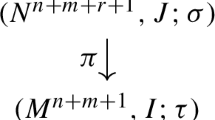Abstract
This paper considers near-equilibrium systems of ordinary differential equations with explicit separation of the slow and stable manifolds. Formal B-series like those previously used to analyze highly oscillatory systems or to construct modified equations are employed here to construct expansions of the change of variables, the center invariant manifold and the reduced model. The new approach may be seen as a process of reduction to a normal form, with the surprising advantage, as compared to the standard view conveyed by the celebrated center manifold theorem, that it is possible to recover the complete solution at any time through an explicitly computable way.












Similar content being viewed by others
Notes
The equation satisfied by h follows by substituting \(z=\varepsilon h(x)\) into \(\dot{z} = - \Lambda z + \varepsilon g(x,z)\).
Up to our knowledge, this is the first time that an explicit and generic representation of \(x_0^\varepsilon \) is provided.
In order to manipulate finite series, we have considered here polynomial functions. Though appropriate truncations of the series employed in this paper, it is expected that the result persists with exponentially small error terms in \(\varepsilon \) under less restrictive assumptions.
Note that for all \(\lambda \in \mathbb {R}\), \(f_k(x,\lambda z) = \lambda ^k f_k(x,z)\) and similarly for \(g_k\).
The rigorous definition of the star product requires a few notations (see [8]): an ordered subtree of \(w \in \mathfrak {T}\) is a subset s of the set of all |w| colored-indexed vertices of w, which is connected (by edges of the tree w) and contains the root of w (if \(s \ne \emptyset \)). The collection of all ordered subtrees of w is denoted by \(\mathcal{S}(w)\). Associated with an ordered subtree s are, on the one hand, the collection \(w \setminus s\) of rooted trees that remain when the vertices of the subtree s together with its adjacent edges are removed from the tree w and, on the other hand, the rooted tree \(w''_s\) given by the vertices of s with root and edges from tree w. With these notations at hand, the coefficient \(c_w\) may be computed through the formula
$$\begin{aligned} (a \star b)_w = \sum _{s \in \mathcal{S}(w)} b(w''_s) \prod _{w' \in w \setminus s} a(w'). \end{aligned}$$This equation is documented in almost every book on the center manifold theorem, see, for instance, [5].
It is actually obtained as the result of a very high-precision simulation.
References
P. Auger and R. Roussaries. Complex ecological models with simple dynamics : from individual to populations. Acta Biotheoretica, 42:111–136, 1994.
J.C. Butcher. An algebraic theory of integration methods. Computational mathematics, 26:79–106, 1972.
J.C. Butcher. The numerical analysis of ordinary differential equations. Wiley-Interscience Publication, 1987.
M.P. Calvo, P. Chartier, A. Murua, and J.M. Sanz-Serna. Numerical experiments with the stroboscopic method. Appl. Numer. Math., 61:1077–1095, 2011.
J. Carr. Applications of Centre Manifold Theory, volume 35 of Applied Mathematical Sciences Series. Springer-Verlag, 1981.
F. Castella, P. Chartier, and J. Sauzeau. Analysis of a time-dependent problem of mixed migration and population dynamics. Submitted, 2016.
F. Castella, J.P Hoffbeck, and Y. Lagadeuc. A reduced model for spatially structured predator-prey systems with fast spatial migrations and slow demographic evolutions. Asymptotic Analysis, 61(3–4):125–175, 2009.
P. Chartier, E. Hairer, and G. Vilmart. Algebraic structures of B-series. Foundations of Computational Mathematics, 10:407–427, 2010.
P. Chartier, J. Makazaga, M. Murua, and G. Vilmart. Multi-revolution composition methods for highly oscillatory differential equations. Numerische Mathematik, 128(1):167–192, 2015.
P. Chartier, A. Murua, and J.M. Sanz-Serna. Higher order averaging, formal series and numerical integration I: B-series. Foundations of Computational Mathematics, 10:695–727, 2010.
P. Chartier, A. Murua, and J.M. Sanz-Serna. A formal series approach to averaging: exponentially small error estimates. Discrete ans Continuous Dynamical Systems, 32:3009–3027, 2012.
P. Chartier, A. Murua, and J.M. Sanz-Serna. Higher order averaging, formal series and numerical integration II: the quasi-periodic case. Foundations of Computational Mathematics, 12:471–508, 2012.
P. Chartier, A. Murua, and J.M. Sanz-Serna. Higher order averaging, formal series and numerical integration III: error bounds. Foundations of Computational Mathematics, 15:591–612, 2015.
E. Hairer, C. Lubich, and G. Wanner. Geometric numerical integration. Structure preserving algorithms for ordinary differential equations, volume 31 of Computational Mathematics. Springer-Verlag, 2006.
A. Murua and J.M. Sanz-Serna. Averaging and computing normal forms with word series algorithms. 2016.
A. Murua and J.M. Sanz-Serna. Computing normal forms and formal invariants of dynamical systems by means of word series. Nonlinear Analysis, Theory, Methods and Applications, 2016.
A. Murua and J.M. Sanz-Serna. Word series for dynamical systems and their numerical integrators. Foundations of Computational Mathematics, 2016.
J.C. Poggiale and P. Auger. Fast oscillating migations in a predator–prey model. Mathematical models and methods in applied sciences, 6(2):226–271, 1996.
Author information
Authors and Affiliations
Corresponding author
Additional information
Communicated by Hans Munthe-kaas.
Rights and permissions
About this article
Cite this article
Castella, F., Chartier, P. & Sauzeau, J. A Formal Series Approach to the Center Manifold Theorem. Found Comput Math 18, 1397–1434 (2018). https://doi.org/10.1007/s10208-017-9371-y
Received:
Revised:
Accepted:
Published:
Issue Date:
DOI: https://doi.org/10.1007/s10208-017-9371-y
Keywords
- Center manifold
- Stable manifold
- Slow manifold
- Shadowing principle
- Change of variables
- B-series
- Trees
- Composition product
- Normal form
- Model reduction



